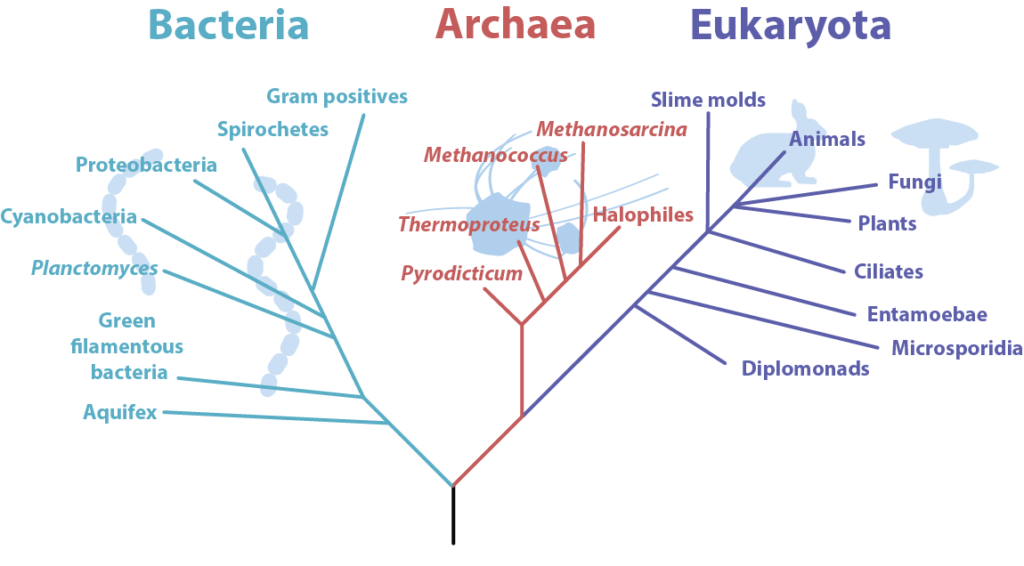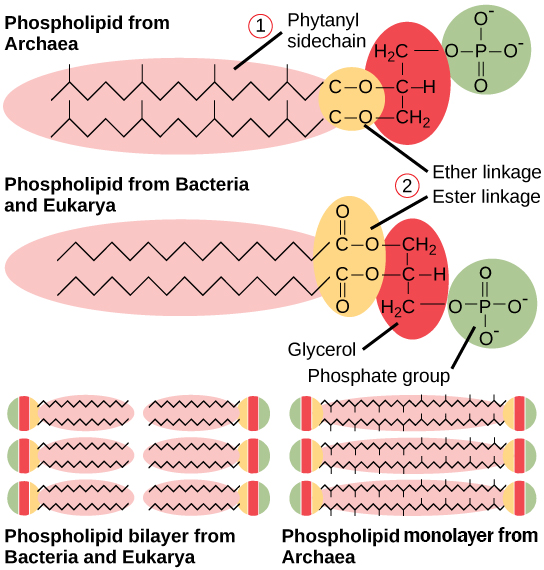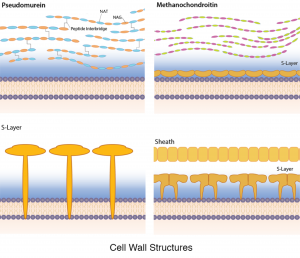7 Archaea
The Archaea are a group of organisms that were originally thought to be bacteria (which explains the initial name of “archaeabacteria”), due to their physical similarities. More reliable genetic analysis revealed that the Archaea are distinct from both Bacteria and Eukaryotes, earning them their own domain in the Three Domain Classification originally proposed by Woese in 1977, alongside the Eukarya and the Bacteria.

Similarities to Bacteria
So, why were the archaea originally thought to be bacteria? Perhaps most importantly, they lack a nucleus or other membrane-bound organelles, putting them into the prokaryotic category (if you are using the traditional classification scheme). Most of them are unicellular, they have 70S sized ribosomes, they are typically a few micrometers in size, and they reproduce asexually only. They are known to have many of the same structures that bacteria can have, such as plasmids, inclusions, flagella, and pili. Capsules and slime layers have been found but appear to be rare in archaea.
While archaea were originally isolated from extreme environments, such as places high in acid, salt, or heat, earning them the name “extremophiles,” they have more recently been isolated from all the places rich with bacteria: surface water, the ocean, human skin, soil, etc.
Key Differences
Plasma Membrane
There are several characteristics of the plasma membrane that are unique to Archaea, setting them apart from other domains. One such characteristic is chirality of the glycerol linkage between the phopholipid head and the side chain. In archaea it is in the L-isomeric form, while bacteria and eukaryotes have the D-isomeric form. A second difference is the presence of an ether-linkage between the glycerol and the side chain, as opposed to the ester-linked lipids found in bacteria and eukaryotes. The ether-linkage provides more chemical stability to the membrane. A third and fourth difference are associated with the side chains themselves, unbranched fatty acids in bacteria and eukaryotes, while isoprenoid chains are found in archaea. These isoprenoid chains can have branching side chains.

Lastly, the plasma membrane of Archaea can be found as monolayers, where the isoprene chains of one phospholipid connect with the isoprene chains of a phospholipid on the opposite side of the membrane. Bacteria and eukaryotes only have lipid bilayers, where the two sides of the membrane remain separated.
Cell Wall
Like bacteria, the archaeal cell wall is a semi-rigid structure designed to provide protection to the cell from the environment and from the internal cellular pressure. While the cell walls of bacteria typically contain peptidoglycan, that particular chemical is lacking in archaea. Instead, archaea display a wide variety of cell wall types, adapted for the environment of the organism. Some archaea lack a cell wall altogether.
While it is not universal, a large number of Archaea have a proteinaceous S-layer that is considered to be part of the cell wall itself (unlike in Bacteria, where an S-layer is a structure in addition to the cell wall). For some Archaea the S-layer is the only cell wall component, while in others it is joined by additional ingredients (see below). The archaeal S-layer can be made of either protein or glycoprotein, often anchored into the plasma membrane of the cell. The proteins form a two-dimensional crystalline array with a smooth outer surface. A few S-layers are composed of two different S-layer proteins.
While archaea lack peptidoglycan, a few contain a substance with a similar chemical structure, known as pseudomurein. Instead of NAM, it contains N-acetylalosaminuronic acid (NAT) linked to NAG, with peptide interbridges to increase strength.
Methanochondroitin is a cell wall polymer found in some archaeal cells, similar in composition to the connective tissue component chondroitin, found in vertebrates.
Some archaea have a protein sheath composed of a lattice structure similar to an S-layer. These cells are often found in filamentous chains, however, and the protein sheath encloses the entire chain, as opposed to individual cells.
Cell Wall Structural Diversity.
Ribosomes
While archaea have ribosomes that are 70S in size, the same as bacteria, it was the rRNA nucleotide differences that provided scientists with the conclusive evidence to argue that archaea deserved a domain separate from the bacteria. In addition, archaeal ribosomes have a different shape than bacterial ribosomes, with proteins that are unique to archaea. This provides them with resistance to antibiotics that inhibit ribosomal function in bacteria.
Structures
Many of the structures found in bacteria have been discovered in archaea as well, although sometimes it is obvious that each structure was evolved independently, based on differences in substance and construction.
Cannulae
Cannulae, a structure unique to archaea, have been discovered in some marine archaeal strains. These hollow tube-like structures appear to connect cells after division, eventually leading to a dense network composed of numerous cells and tubes. This could serve as a means of anchoring a community of cells to a surface.
Hami (sing. hamus)
Another structure unique to archaea is the hamus, a long helical tube with three hooks at the far end. Hami appear to allow cells to attach both to one another and to surfaces, encouraging the formation of a community.
Pili (sing. pilus)
Pili have been observed in archaea, composed of proteins most likely modified from the bacterial pilin. The resulting tube-like structures have been shown to be used for attachment to surfaces.
Flagella (sing. flagellum)
The archaeal flagellum, while used for motility, differs so markedly from the bacterial flagellum that it has been proposed to call it an “archaellum,” to differentiate it from its bacterial counterpart.
What is similar between the bacterial flagellum and the archaeal flagellum? Both are used for movement, where the cell is propelled by rotation of a rigid filament extending from the cell. After that the similarities end.
What are the differences? The rotation of an archaeal flagellum is powered by ATP, as opposed to the proton motive force used in bacteria. The proteins making up the archaeal flagellum are similar to the proteins found in bacterial pili, rather than the bacterial flagellum. The archaeal flagellum filament is not hollow so growth occurs when flagellin proteins are inserted into the base of the filament, rather than being added to the end. The filament is made up of several different types of flagellin, while just one type is used for the bacterial flagellum filament. Clockwise rotation pushes an archaeal cells forward, while counterclockwise rotation pulls an archaeal cell backwards. An alternation of runs and tumbles is not observed.
Classification
Currently there are two recognized phyla of archaea: Euryarchaeota and Proteoarchaeota. Several additional phyla have been proposed (Nanoarchaeota, Korarchaeota, Aigarchaeota, Lokiarchaeota), but have yet to be officially recognized, largely due to the fact that the evidence comes from environmental sequences only.
Key Words
Archaea, L-isomeric form, D-isomeric form, ether-linkages, ester-linkages, isoprenoid chains, branching side chains, lipid monolayer, lipid bilayer, S-layer, pseudomurein, N-acetylalosaminuronic acid (NAT), methanochondroitin, protein sheath, cannulae, hamus/hami, pilus/pili, flagellum/flagella, archaellum, Euryarchaeota, Proteoarchaeota.
Study Questions
- How are the archaea similar to bacteria?
- Describe the differences between the plasma membranes of archaea, compared to bacteria & eukaryotes. Explain the differences.
- What types of cell walls exist in Archaea and what are they composed of?
- How are archaeal ribosomes both similar and different from bacterial ribosomes?
- How do the pili of archaea differ from those of bacteria?
- What are cannulae and hami? What role could they play for archaea?
- How does archaeal flagella differ from bacterial flagella, in terms of composition, assembly, and function?
- Understand the commonalities and differences between archaea and bacteria, in terms of physical characteristics.
Exploratory Questions (OPTIONAL)
- What explains the fact that archaea appear to be more closely related to eukaryotes, despite their physical similarities to bacteria?


